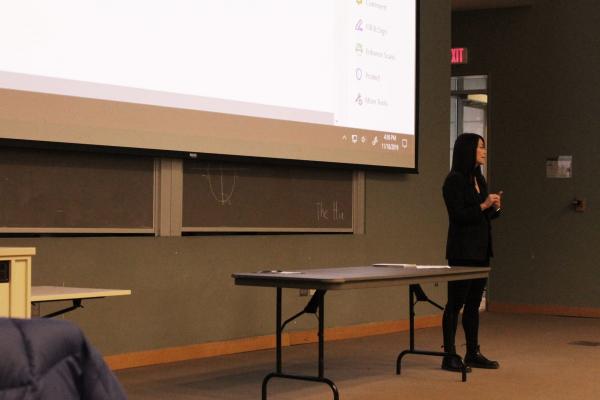Internment: Now and Then

Lantern Article: Workshop Puts Contemporary Migrant Detention in Historical Perspective
by Joseph Schmittgen
Ohio State students and faculty gathered in Hagerty Hall Monday afternoon for a workshop titled “Internment: Now and Then,” which provided insight into modern-day migrant detention by discussing the history of internment — the state of being confined as a prisoner, often for political or military reasons — in the United States through a series of presentations.
The event — organized by the Center for Ethnic Studies, co-sponsored by the Institute for Democratic Engagement and Accountability as well as the Center for Ethics and Human Values — brought together three visiting professors, who developed individual presentations to consider the experiences of the internment of American Indians and Japanese Americans, according to a release from the Ohio State Multicultural Center.
The workshop aimed to bring a better understanding of the connections to contemporary migrant detention, according to the release. The presenters included Natalie Cisneros, an associate professor in philosophy at Seattle University, Lynn Itagaki, an associate professor in English and women’s and gender studies at the University of Missouri and Addie Rolnick, a professor of law at the University of Nevada, Las Vegas.
Namiko Kunimoto, an associate professor of art history and organizer of the event, said the inspiration behind the event stemmed from current events.
“It began in June with these mass detentions peaking,” Kunimoto said. “We knew we had to organize and do something about it, so I think that was the origin.”
The phenomena of “migrant detention” refers to the policy enforced by the United States Immigration and Customs Enforcement, which calls for the detainment of immigrants in detention centers under suspicion of violating their immigrant status by either entering the country undocumented or violating their visa, according to a report by the International Detention Coalition.
The workshop began with Ines Valdez, an associate professor and director in the Latina/o Studies Program, who shared an introduction about the overarching inspiration behind the event.
Valdez said it was upon hearing about protests from Japanese Americans against the Trump administration’s decision to reopen Fort Sill, a military facility in Oklahoma, to house Central American asylum-seeking children who had been separated from their parents that the organizers of the workshop began to consider the current mass detainment of migrants in historical perspective.
She said from 1894 to 1914 the fort was used as a prisoner camp for the Apache tribe, then was reopened as an internment camp from 1942 until 1945 for Japanese Americans during World War II. It opened again in 2014 as part of the Obama administration’s response to the arrival of asylum-seeking children from Central America.
Itagaki followed Valdez with a presentation of her own, discussing the history of Japanese American internment during World War II.
She described the racist terms under which internment was established and the inhumane conditions the victims had faced in different internment camps throughout the country.
“Returning to Fort Sill and to the recent protests and a combined effort in terms of Japanese Americans, Native Americans and combined allies — they’ve been trying to prevent something like this happening today,” Itagaki said.
She was followed by a presentation by Rolnick, who discussed the history of the internment of Native Americans and how it led to the development of Native American boarding schools. She also spoke about how this history influenced Native American adolescents and children in the juvenile delinquent system today.
Rolnick said she studies how current detention centers were repurposed from being Native American training schools and even internment facilities.
“I tried to mine some of the linkages between what happened to Indian people in a lot of these facilities and other people,” Rolnick said.
The workshop series of presentations came to close with Cisneros, whose presentation looked more into the concepts of biopower and biopolitics and how that has played a role in thinking about internment as well as current migrant detention.
“For me in particular, it’s really important to think about the history of immigrant detainment as something that goes back further than the Trump regime,” she said. “Because if we don’t think about it that way, we tend to make the same mistakes we’ve made in the past, and even if the regime changes in the next two years, we still have this overarching set of strategies and methods of power that systematically expose migrants.”
Cisneros said the presentation prompted her to think more about how the histories of communities of color in the United States intersect and overlap, and to question how citizens should resist the ways these marginalized communities have been targeted.
Mel Herzog, a third-year in international relations and diplomacy, said the event expanded her knowledge on the topic.
“I kinda knew that on a surface level about how it happened, so it was really interesting to hear more details of what exactly happened in this period of internment and how it relates to today,” Herzog said.
